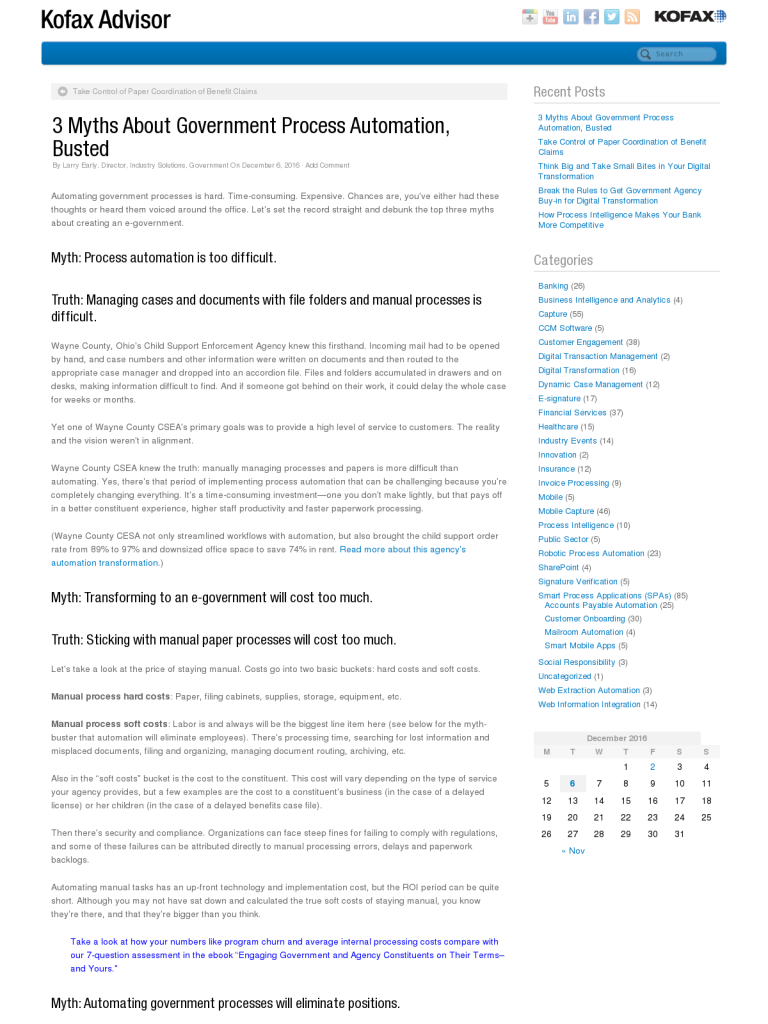3 Myths About Government Process Automation, Busted
Blog: Kofax - Smart Process automation
Automating government processes is hard. Time-consuming. Expensive. Chances are, you’ve either had these thoughts or heard them voiced around the office. Let’s set the record straight and debunk the top three myths about creating an e-government.
Myth: Process automation is too difficult.
Truth: Managing cases and documents with file folders and manual processes is difficult.
Wayne County, Ohio’s Child Support Enforcement Agency knew this firsthand. Incoming mail had to be opened by hand, and case numbers and other information were written on documents and then routed to the appropriate case manager and dropped into an accordion file. Files and folders accumulated in drawers and on desks, making information difficult to find. And if someone got behind on their work, it could delay the whole case for weeks or months.
Yet one of Wayne County CSEA’s primary goals was to provide a high level of service to customers. The reality and the vision weren’t in alignment.
Wayne County CSEA knew the truth: manually managing processes and papers is more difficult than automating. Yes, there’s that period of implementing process automation that can be challenging because you’re completely changing everything. It’s a time-consuming investment—one you don’t make lightly, but that pays off in a better constituent experience, higher staff productivity and faster paperwork processing.
(Wayne County CESA not only streamlined workflows with automation, but also brought the child support order rate from 89% to 97% and downsized office space to save 74% in rent. Read more about this agency’s automation transformation.)
Myth: Transforming to an e-government will cost too much.
Truth: Sticking with manual paper processes will cost too much.
Let’s take a look at the price of staying manual. Costs go into two basic buckets: hard costs and soft costs.
Manual process hard costs: Paper, filing cabinets, supplies, storage, equipment, etc.
Manual process soft costs: Labor is and always will be the biggest line item here (see below for the myth-buster that automation will eliminate employees). There’s processing time, searching for lost information and misplaced documents, filing and organizing, managing document routing, archiving, etc.
Also in the “soft costs” bucket is the cost to the constituent. This cost will vary depending on the type of service your agency provides, but a few examples are the cost to a constituent’s business (in the case of a delayed license) or her children (in the case of a delayed benefits case file).
Then there’s security and compliance. Organizations can face steep fines for failing to comply with regulations, and some of these failures can be attributed directly to manual processing errors, delays and paperwork backlogs.
Automating manual tasks has an up-front technology and implementation cost, but the ROI period can be quite short. Although you may not have sat down and calculated the true soft costs of staying manual, you know they’re there, and that they’re bigger than you think.
Take a look at how your numbers like program churn and average internal processing costs compare with our 7-question assessment in the ebook “Engaging Government and Agency Constituents on Their Terms–and Yours.”
Myth: Automating government processes will eliminate positions.
Truth: Automation frees knowledge workers to serve constituents instead of process papers.
As noted above in the list of manual process soft costs, your employees spend an inordinate (and likely undocumented) amount of time organizing papers, processing files, finding lost items, managing documents, archiving and looking up, and tracking down papers for constituents inquiring about their status.
In fact, a recent IDC survey said knowledge workers spend an average of 136 minutes (over two hours) per week just searching for documents, let alone performing all those other paperwork management tasks.
How could your staff use those two hours in service to constituents instead? Better yet, how could staff use those freed-up hours to focus on the constituents most in need of your services, the ones who tend to fall through the cracks because there’s not enough time in the day to move through the backlog?
Automation isn’t necessarily about elimination; it’s about freeing up knowledge workers’ time to do higher-value work that truly serves your customer base.
Ready to learn more about government process automation? Watch our 3-minute video on application automation.
Leave a Comment
You must be logged in to post a comment.








